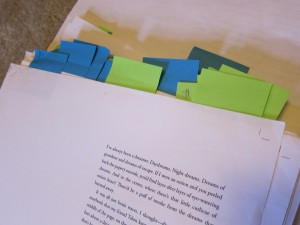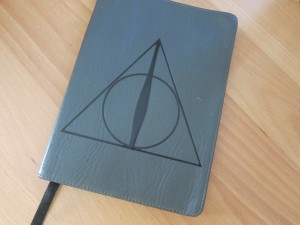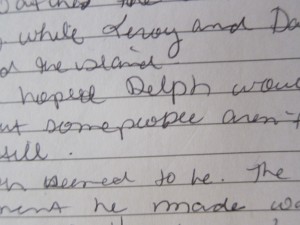Readers get to see what our stories look like when they are bound and published. But what do they look like along the way? Michelle Knudsen thought you (yes, you) might be interested in knowing the answer to that, so she started a blog hop on the writing process. Sarah Sullivan, author of the All That’s Missing, tagged me, so now it’s my turn. I’ve loved reading about how other writers do what they do. I’ll even admit to taking notes, with the thought that I might tweak my own process, the way I did when Sara Lewis Holmes let me borrow Save the Cat. In the end, though, I tend to channel my inner Popeye and go back to old habits. Here’s my process, for better or worse:
What am I currently working on?
I’m always working on a few projects at once. Right now those include: A grounded-in-reality science fiction middle grade about some kids in the fictional town in Maine; a grounded-in-reality middle grade that I suppose I will have to call historic fiction because it’s set more than 20 years ago (written with my friend Wendy Shang and the second time I’m trying this co-author business). I’m also working on revisions for a young adult novel that is set in 2000. Is that historic fiction, too? Criminy. I’ll just call it a “period piece;” I still have a hard time thinking of things that happen in my lifetime as “history.”

Proofing a pdf for Dream Boy. This is more organized that you'll usually find me.
How does my work differ from others of its genre?
This is the hardest question to answer. I know because I just got this same question from Kate Ormand, on a post that will run this June. So I’m going to change the question and ask what informs my work, because that sounds a little less high fallutin’. The answer is: the physical world outside my window and my background as a journalist. When I was a reporter, my favorite type of story to write was the slice-of-life story, and I try to make sure that my fiction is like that, too: a slice of whatever world I’m sharing. As a reporter, I’ve always listened to the way people talk and I still do. And as a reporter, I’ve written down tangible details about real things, which I always do when I write fiction. Sometimes I don’t know when to stop researching, and that can be a problem. But I always know when to start. I’m also a product of the places I’ve lived and visited. Blacksburg, Va., was that place for the longest time, so bits of that town creep into pretty much every story, as do recent vacation spots and the frogs in my backyard pond.
Why do I write what I write?
I read an article once that said writers basically write one thing because they have one story they’re trying to tell. I don’t think I’m trying to tell the exact same story over and over, but there are certainly themes that come up in everything I write, in the things that have been published and the things that haven’t. I made a list once, and came up with religion, cancer, global warming and brother-sister relationships. I’m not sure what title I’d put on a list like that. Things that scare me? Things that make the scary things better?I don’t think I write those things all at once. The religion creeps in either as a celebration of Judaism or with my characters dealing with some type of prejudice because of it. In Canary in the Coal Mine, there’s an uncle who is prejudiced against pigeons and that basically came from people I knew growing up. The brother-sister relationships are usually good, the environment is often bad, and I have a hard time writing without humming REM songs (specifically The End of the World As We Know It. For the record, I do not feel fine about it.)
How does my individual writing process work?
Normally, I’m a whittler. If you’re picturing me on the porch, with a knife in one hand and a thick stick in the other? That’s how I picture myself. At the end of the day, the stick is supposed to be a bear or a pig. Except that I don’t have a front porch. And I’m not very good with a knife. But I do whittle words. My first draft is rough, like the stick, with all of the bark and knobs and maybe even a leaf or two. And on my next draft, the bark comes off and the wood is smoother. With each pass, I get a bigger pile of wood shavings and the story takes more shape. My sentences don’t always start out pretty. My stories are filled with Xs and blanks, which goes back to my journalism days. (My friend Kevin couldn’t write the second graph until he got the perfect lead. Sometimes I worked that way, and sometimes I thought of the perfect lead on the way back from an assignment. More often, I perfected the lead at the end.) Anyway, with each subsequent pass, I shave my story and shape it. My friend Wendy, who I hope will weigh in here next week, is the opposite. I think I actually said to her:
Just blurp it out!
I don’t think Wendy blurps. I’ll let her comment next week.

My current writing notebook.
I’ve been a little unfocussed lately on my solo work, distracted by all kinds of things, particularly the internet, so those projects are taking awhile, too. When I get blocked, I tend to look at e-mail instead of working through the thing that’s blocking me. I’m trying to cure that by doing more of my work away from the computer. My second process problem recently has been with the items I’m working on. Usually, I work on one long thing and one short thing at a time. That’s been a good fit. Working on multiple long projects at the same time is not such a good fit. It takes a while to get back to the proper voice. As a result, I’ve been moving forward in inches instead of yards. Another leftover from my journalism career: I need a deadline to get things done. Fake deadlines don’t seem to work. Think I need to ask my agent for a real one this week…

Writing by hand to eliminate internet distractions.
Next up to talk about their writing processes are Wendy Shang, author of The Great Wall of Lucy Wu, who will be right here next week.
